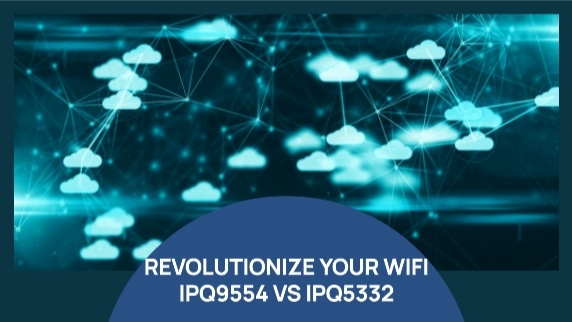From IPQ5332 to IPQ9554: Interpret the Wi-Fi 7 chip for different positioning

From IPQ5332 to IPQ9554: Interpret the Wi-Fi 7 chip for different positioning
Wi-Fi 7 is the latest generation of wireless networking technology, which is based on the IEEE 802.11be standard and offers significant improvements in speed, latency, capacity and stability compared to previous generations of Wi-Fi technology. Here are some of the key features and improvements about Wi-Fi 7:
** Higher transmission rate ** :The maximum theoretical transfer rate of Wi-Fi 7 can reach 30 Gbps, which is much higher than the 9.6 Gbps of Wi-Fi 6.This is thanks to more efficient modulation technology (4096-QAM) and wider channel bandwidth (up to 320 MHz).
** Multi-Connect Operation (MLO) ** :Wi-Fi 7 supports multi-connection operation, allowing devices to connect to multiple frequency bands (2.4 GHz, 5 GHz, and 6 GHz) at the same time, improving data transfer rates and connection stability.This technology can also reduce latency, as devices can choose the fastest and most stable path to transmit data.
** Enhanced Multi-User MIMO (MU-MIMO) ** :Wi-Fi 7 supports enhanced multi-user multiple-in/multiple-out technology, enabling more devices to be served simultaneously.This is especially useful for scenarios where there are a large number of connected devices in home and office environments.
** Lower latency ** :Wi-Fi 7 has been optimized to reduce latency, making it more suitable for real-time applications such as online gaming, virtual reality (VR) and augmented reality (AR).
** Intelligent Spectrum Management ** :Wi-Fi 7 features smarter spectrum management that makes better use of available spectrum, reduces interference, and improves spectrum efficiency.
** Higher energy efficiency ** :
The new energy-saving mechanism enables Wi-Fi 7 to reduce energy consumption and extend device battery life while maintaining high performance.
** Backward Compatible ** :Wi-Fi 7 is backward compatible with Wi-Fi 6 and Wi-Fi 5, which means that a user's device can work in a Wi-Fi 7 network even if it hasn't been upgraded to Wi-Fi 7 yet.
These enhancements to Wi-Fi 7 will make wireless networks faster, more efficient and more reliable to meet the growing data demands and new application scenarios in the coming years.Here's a look at the difference between the two chips:Both IPQ5332 and IPQ9554 are system-on-a-chip (SoC) developed by Qualcomm for use in Wi-Fi 7 routers. Both chips, while designed to support Wi-Fi 7, differ in performance and usage. Here are the main differences:
IPQ5332 chip
** Positioning and Use ** :
** Mid-market ** : The IPQ5332 is primarily targeted at the mid-market, suitable for Wi-Fi 7 routers and access points in homes and small and medium-sized businesses.
** Performance and Specifications ** :
**CPU Architecture ** : The IPQ5332 typically uses a quad-core ARM Cortex-A53 processor.
**Wi-Fi Support ** : Supports Wi-Fi 7 with basic Wi-Fi 7 features and performance, suitable for most home users and small businesses.
** Memory and Storage ** : Supports common memory and storage configurations, suitable for most mid-range application scenarios.
** Other features ** :
** Energy Efficiency ** : The design focuses more on energy efficiency and cost effectiveness, suitable for users with limited budgets.
IPQ9554 chip
** Positioning and Use ** :
** High-end market ** : The IPQ9554 is aimed at the high-end market and is suitable for high-performance Wi-Fi 7 routers and enterprise-class access points, satisfying users and enterprises with high network performance requirements.
** Performance and Specifications ** :
**CPU Architecture ** : The IPQ9554 uses a higher performance quad-core ARM Cortex-A73 processor or higher level CPU architecture.
**Wi-Fi Support ** : In addition to Wi-Fi 7 support, the IPQ9554 is more comprehensive in frequency band and channel support, and can handle more concurrent connections and higher data throughput.
** Memory and Storage ** : Supports larger capacity and faster memory and storage configurations, suitable for applications with high data requirements.
** Other features ** :
** Advanced Features ** : The IPQ9554 supports more advanced network features, such as higher QoS (quality of Service), network security features, and more complex network management functions.
** Scalability ** : Designed with higher scalability, suitable for enterprise-class network environments requiring high reliability and high availability.
Summary
IPQ5332 : Suitable for the mid-market, meeting the Wi-Fi needs of homes and small and medium-sized businesses with an emphasis on cost effectiveness and basic performance.
IPQ9554 : For the high-end market, suitable for high-performance and enterprise-class environments, providing stronger performance and more advanced features, suitable for applications with high network requirements.
The choice of chip depends on the specific use needs and budget. For average home users and smes, the IPQ5332 may be sufficient; For enterprises and high-end users who need high-performance network solutions, the IPQ9554 is more suitable.








评论